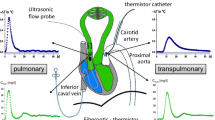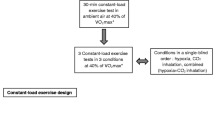Abstract
In healthy humans, changes in cardiac output are commonly accommodated with minimal change in pulmonary artery pressure. Conversely, exposure to hypoxia is associated with substantial increases in pulmonary artery pressure. In this study we used non-invasive measurement of an index of pulmonary artery pressure, the maximum systolic pressure difference across the tricuspid valve (ΔPmax), to examine the pulmonary vascular response to changes in blood flow during both air breathing and hypoxia. We used Doppler echocardiography in 33 resting healthy humans breathing air over 6–24 h to measure spontaneous diurnal variations in ΔPmax and cardiac output. Cardiac output varied by up to ~2.5 l/min; ΔPmax varied little with cardiac output [0.61±0.74 (SD) mmHg min l−1]. Eight of the volunteers were also exposed to eucapnic hypoxia (end-tidal \(P_{{\rm O}_{2}} = 50\,{\text{mmHg}}\)) for 8 h. In this group ΔPmax rose progressively from 21 mmHg to 37 mmHg over 8 h. By comparing diurnal variations in ΔPmax during air breathing with changes in ΔPmax during hypoxia in the same eight individuals, we concluded that only approximately 5% of the changes in ΔPmax during hypoxia could be attributed to concurrent changes in cardiac output. The low sensitivity of ΔPmax to changes in cardiac output makes it a useful index of hypoxic pulmonary vasoconstriction in healthy humans.




Similar content being viewed by others
References
Balanos GM, Dorrington KL, Robbins PA (2002) Desferrioxamine elevates pulmonary vascular resistance in humans: potential for involvement of HIF-1. J Appl Physiol 92(6):2501–2507
Balanos GM, Talbot NP, Dorrington KL, Robbins PA (2003) Human pulmonary vascular response to 4 h of hypercapnia and hypocapnia measured using Doppler echocardiography. J Appl Physiol 94(4):1543–1551
Banister J, Torrance RW (1960) The effects of the tracheal pressure upon flow: pressure relations in the vascular bed of isolated lungs. Q J Exp Physiol 45:352–367
Borst HG, McGregor M, Whittenberger JL, Berglund E (1956) Influence of pulmonary arterial and left atrial pressures on pulmonary vascular resistance. Circ Res 4:393–399
Chemla D, Castelain V, Humbert M, Hebert JL, Simonneau G, Lecarpentier Y, Herve P (2004) New formula for predicting mean pulmonary artery pressure using systolic pulmonary artery pressure. Chest 126(4):1313–1317
Dorrington KL, Clar C, Young JD, Jonas M, Tansley JG, Robbins PA (1997) Time course of the human pulmonary vascular response to 8 hours of isocapnic hypoxia. Am J Physiol 273(3Pt2):H1126–H1134
Grimminger F, Spriestersbach R, Weissmann N, Walmrath D, Seeger W (1995) Nitric oxide generation and hypoxic vasoconstriction in buffer-perfused rabbit lungs. J Appl Physiol 78(4):1509–1515
Groves BM, Reeves JT, Sutton JR, Wagner PD, Cymerman A, Malconian MK, Rock PB, Young PM, Houston CS (1987) Operation Everest II: elevated high-altitude pulmonary resistance unresponsive to oxygen. J Appl Physiol 63(2):521–530
Grünig E, Mereles D, Hildebrandt W, Swenson ER, Kubler W, Kuecherer H, Bärtsch P (2000) Stress Doppler echocardiography for identification of susceptibility to high altitude pulmonary edema. J Am Coll Cardiol 35(4):980–987
Howard LS, Barson RA, Howse BP, McGill TR, McIntyre ME, O’Connor DF, Robbins PA (1995) Chamber for controlling end-tidal gas tensions over sustained periods in humans. J Appl Physiol 78(3):1088–1091
Hughes JMB, Morrell NW (2001) Pulmonary circulation. From basic mechanisms to clinical practice. Imperial College Press, London
Hyman AL, Kadowitz PJ (1989) Analysis of responses to sympathetic nerve stimulation in the feline pulmonary vascular bed. J Appl Physiol 67(1):371–376
Kawashima A, Kubo K, Kobayashi T, Sekiguchi M (1989) Hemodynamic responses to acute hypoxia, hypobaria, and exercise in subjects susceptible to high-altitude pulmonary edema. J Appl Physiol 67(5):1982–1989
Kerbaul F, Bellezza M, Guidon C, Roussel L, Imbert M, Carpentier JP, Auffray JP (2000) Effects of sevoflurane on hypoxic pulmonary vasoconstriction in anaesthetized piglets. Br J Anaesth 85(3):440–445
Lodato RF, Michael JR, Murray PA (1985) Multipoint pulmonary vascular pressure-cardiac output plots in conscious dogs. Am J Physiol 249(2Pt2):H351–H357
Marshall BE, Clarke WR, Costarino AT, Chen L, Miller F, Marshall C (1994) The dose–response relationship for hypoxic pulmonary vasoconstriction. Respir Physiol 96(2–3):231–247
Naeije R (2004) Pulmonary vascular function. In: Peacock AJ and Rubin LJ (eds) Pulmonary circulation: diseases and their treatment. Arnold, London, pp 3–13
Peacock AJ, Challenor V, Sutherland G (1990) Estimation of pulmonary artery pressure by Doppler echocardiography in normal subjects made hypoxic. Respir Med 84(4):335–337
Reeves JT, Groves BM, Cymerman A, Sutton JR, Wagner PD, Turkevich D, Houston CS (1990) Operation Everest II: cardiac filling pressures during cycle exercise at sea level. Respir Physiol 80(2–3):147–154
Talbot NP, Balanos GM, Dorrington KL, Robbins PA (2005) Two temporal components within the human pulmonary vascular response to ~2 hours of isocapnic hypoxia. J Appl Physiol 98:1125–1139
Welling KL, Sander M, Ravn JB, Larsen B, Abildgaard U, Amtorp O (1997) Effect of alveolar hypoxia on segmental pulmonary vascular resistance and lung fluid balance in dogs. Acta Physiol Scand 161(2):177–186
Author information
Authors and Affiliations
Corresponding author
Rights and permissions
About this article
Cite this article
Balanos, G.M., Talbot, N.P., Robbins, P.A. et al. Separating the direct effect of hypoxia from the indirect effect of changes in cardiac output on the maximum pressure difference across the tricuspid valve in healthy humans. Pflugers Arch - Eur J Physiol 450, 372–380 (2005). https://doi.org/10.1007/s00424-005-1422-6
Received:
Revised:
Accepted:
Published:
Issue Date:
DOI: https://doi.org/10.1007/s00424-005-1422-6




